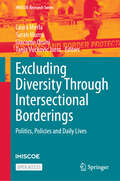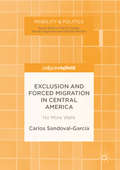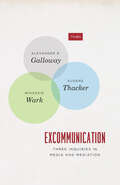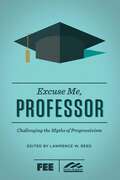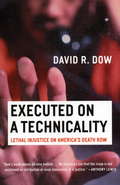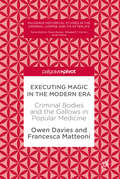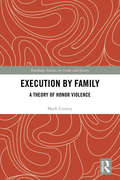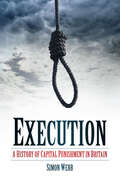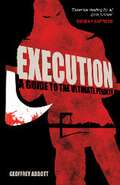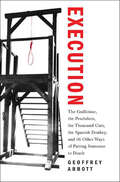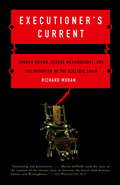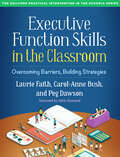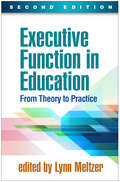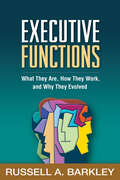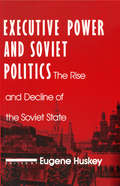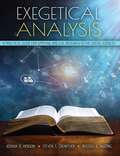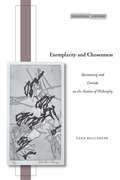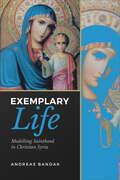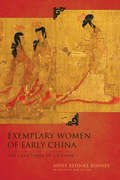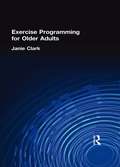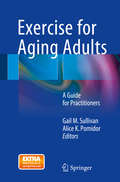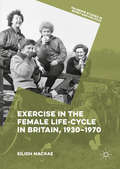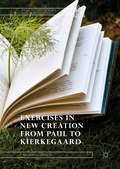- Table View
- List View
Excluding Diversity Through Intersectional Borderings: Politics, Policies and Daily Lives (IMISCOE Research Series)
by Laura Merla Sarah Murru Giacomo Orsini Tanja Vuckovic JurosThis open access book critically examines how discourses and policies target and exclude migrants and their families in Europe and North America along racial, gender and sexuality lines, and how these exclusions are experienced and resisted. Building on the influential notion of intersectional borderings, it delves deep into how these discourses converge and diverge, highlighting the underlying normative constructs of family, gender, and sexuality. First, it examines how radical-right and conservative political movements perpetuate exclusionary practices and how they become institutionalized in migration, welfare, and family policies. Second, it examines the dynamic responses they provoke—both resistance and reinforcement—among those affected in their everyday lives. Bringing together studies from political and social sciences, it offers a vital contribution to the expanding field of migrant family governance and exclusion and is essential for understanding the complex processes of exclusion and the movements that challenge and sustain them. It expands academic discussions on populism and the politics of exclusion by linking them to the politicization of intimacy and family life. With diverse case studies from Europe, North, and Central America, it appeals to students, academics, and policymakers, informing future mobilizations against discriminatory and exclusionary tendencies in politics and society.
Exclusion and Forced Migration in Central America: No More Walls (Mobility & Politics)
by Carlos Sandoval-GarcíaThis book marks a critical contribution to the intercultural dialogue about immigration. Each year, thousands of Central Americans leave their countries and walk across Mexico, seeking to reach the United States. The author explores the dispossession process that drives these migrants from their homes and argues that they are caught in a kind of trap: forced to emigrate, but impeded to immigrate. This trap is discussed empirically through the analysis of immigration policies implemented by the United States government and ethnographic fieldwork carried out in some of “albergues” (shelters).
Excommunication: Three Inquiries in Media and Mediation (TRIOS)
by Alexander R. Galloway Eugene Thacker McKenzie WarkAlways connect—that is the imperative of today’s media. But what about those moments when media cease to function properly, when messages go beyond the sender and receiver to become excluded from the world of communication itself—those messages that state: “There will be no more messages”? In this book, Alexander R. Galloway, Eugene Thacker, and McKenzie Wark turn our usual understanding of media and mediation on its head by arguing that these moments reveal the ways the impossibility of communication is integral to communication itself—instances they call excommunication. In three linked essays, Excommunication pursues this elusive topic by looking at mediation in the face of banishment, exclusion, and heresy, and by contemplating the possibilities of communication with the great beyond. First, Galloway proposes an original theory of mediation based on classical literature and philosophy, using Hermes, Iris, and the Furies to map out three of the most prevalent modes of mediation today—mediation as exchange, as illumination, and as network. Then, Thacker goes boldly beyond Galloway’s classification scheme by examining the concept of excommunication through the secret link between the modern horror genre and medieval mysticism. Charting a trajectory of examples from H. P. Lovecraft to Meister Eckhart, Thacker explores those instances when one communicates or connects with the inaccessible, dubbing such modes of mediation “haunted” or “weird” to underscore their inaccessibility. Finally, Wark evokes the poetics of the infuriated swarm as a queer politics of heresy that deviates from both media theory and the traditional left. He posits a critical theory that celebrates heresy and that is distinct from those that now venerate Saint Paul. Reexamining commonplace definitions of media, mediation, and communication, Excommunication offers a glimpse into the realm of the nonhuman to find a theory of mediation adequate to our present condition.
Excuse Me, Professor: Challenging the Myths of Progressivism
by Ron Robinson Lawrence W. ReedThere's little truly "progressive" about Progressivism. True progress happens when humans are free, yet the Progressive agenda substantially diminishes freedom while promising the unachievable. Excuse Me, Professor provides a handy reference for anyone actively engaged in advancing liberty, with essential essays debunking more than 50 Progressive clichés.Does the free market truly ignore the poor? Are humans really destroying the Earth? Is the government truly the first best source to relieve distress?Compiled and edited by Lawrence W. Reed in collaboration with the Foundation for Economic Education and Young America's Foundation, this anthology is an indispensable addition to every freedom lover's arsenal of intellectual ammunition.
Executed on a Technicality
by David DowWhen David Dow took his first capital case, he supported the death penalty. He changed his position as the men on death row became real people to him, and as he came to witness the profound injustices they endured: from coerced confessions to disconcertingly incompetent lawyers; from racist juries and backward judges to a highly arbitrary death penalty system.It is these concrete accounts of the people Dow has known and represented that prove the death penalty is consistently unjust, and it's precisely this fundamental-and lethal-injustice, Dow argues, that should compel us to abandon the system altogether.From the Trade Paperback edition.
Executing Magic in the Modern Era
by Owen Davies Francesca MatteoniThis book is open access under a CC BY 4. 0 license This book explores the magical and medical history of executions from the eighteenth to the early twentieth century by looking at the afterlife potency of criminal corpses, the healing activities of the executioner, and the magic of the gallows site. The use of corpses in medicine and magic has been recorded back into antiquity. The lacerated bodies of Roman gladiators were used as a source of curative blood, for instance. In early modern Europe, a great trade opened up in ancient Egyptian mummies and the fat of executed criminals, plundered as medicinal cure-alls. However, this is the first book to consider the demand for the blood of the executed, the desire for human fat, the resort to the hanged man's hand, and the trade in hanging rope in the modern era. It ends by look at the spiritual afterlife of dead criminals.
Execution Culture in Nineteenth Century Britain: From Public Spectacle to Hidden Ritual (Routledge SOLON Explorations in Crime and Criminal Justice Histories)
by Patrick Low Helen Rutherford Clare Sandford-CouchThis edited collection offers multi-disciplinary reflections and analysis on a variety of themes centred on nineteenth century executions in the UK, many specifically related to the fundamental change in capital punishment culture as the execution moved from the public arena to behind the prison wall. By examining a period of dramatic change in punishment practice, this collection of essays provides a fresh historical perspective on nineteenth century execution culture, with a focus on Scotland, Wales and the regions of England. From Public Spectacle to Hidden Ritual has two parts. Part 1 addresses the criminal body and the witnessing of executions in the nineteenth century, including studies of the execution crowd and executioners’ memoirs, as well as reflections on the experience of narratives around capital punishment in museums in the present day. Part 2 explores the treatment of the execution experience in the print media, from the nineteenth and into the twentieth century. The collection draws together contributions from the fields of Heritage and Museum Studies, History, Law, Legal History and Literary Studies, to shed new light on execution culture in nineteenth century Britain. This volume will be of interest to students and academics in the fields of criminology, heritage and museum studies, history, law, legal history, medical humanities and socio-legal studies.
Execution by Family: A Theory of Honor Violence (Routledge Studies in Crime and Society)
by Mark CooneyAcross many parts of the world, violence inflicted in the name of family honor is attracting an increasing amount of attention. Family honor violence, otherwise known as honor-based violence, is physical force inflicted primarily on women for conduct defined as dishonorable. This book explores these conflicts of honor, how they are triggered, how they are handled, and why some lead to death. Drawing on a range of case studies and employing Donald Black’s concept of social geometry, Execution by Family incorporates and goes beyond patriarchy, culture, and kinship to develop a unified theory of family honor violence. It discusses the "honor belt," a series of countries stretching from north Africa to southeast Asia, in which similar forms of inequality, patriarchy, group authority, and gerontocracy are prevalent and how, within the confines of this inequality, honor violence flourishes. Reviewing survey data and pointing to a multi-pronged, cross-national social movement, the book also discusses the future of honor-based violence. Given the growing awareness of family honor violence, Execution by Family will be of interest to anybody concerned with family conflict, violence, crime, and popular morality. It will be invaluable reading for academics and students in the fields of criminology, criminal justice, sociology, social psychology, and anthropology.
Execution: A History of Capital Punishment in Britain
by Simon WebbJudicial hanging is regarded by many as being the quintessentially British execution. However, many other methods of capital punishment have been used in this country; ranging from burning, beheading and shooting to crushing and boiling to death. This book explores these types of execution in detail. Readers may be surprised to learn that a means of mechanical decapitation, the Halifax Gibbet, was being used in England five hundred years before the guillotine was invented. Boiling to death was a prescribed means of execution in this country during the Tudor period. From the public death by starvation of those gibbeted alive, to the burning of women for petit treason, this book examines some of the most gruesome passages of British history.
Execution: A guide to the Ultimate Penalty
by Geoffrey AbbottExecution is a fascinating account of methods of execution through the ages, such as death by cannibalism, being sewn into an animal’s belly and a thousand cuts. From the preparation of the victim to the disposal of the body, Execution answers all the questions you are ever likely to ask, and some you would never want to imagine.
Execution: The Guillotine, the Pendulum, the Thousand Cuts, the Spanish Donkey, and 66 Other Ways of Putting Someone to Death
by Geoffrey AbbottIn his own darkly humorous style, Geoffrey Abbott describes the instruments used and their effectiveness and reveals the macabre origins of familiar phrases such as "gone west" or "drawn a blank," as well as the jargon of the underworld. He covers everything from the preparation of the victim to the disposal of the body. Execution is everything you ever wanted to know about the ultimate penalty---and a lot you never thought to ask. It includes such hair-raising categories as: · Cave of Roses: A rare Swedish method of execution in which the victim was confined to a cave full of snakes and poisonous reptiles.· Bastinado: Involved the victim being caned gently and rhythmically with a lightweight stick on the soles of the feet until the mental collapse and eventual death of the victim.· Sewn in an Animal's Belly: A living person is sewn into the belly of an animal and left to die.· The Spanish Donkey: This method of torture consisted of seating a victim on top of a wall that resembled an inverted "v" with weights attached to the ankles, the weights slowly increased until the victim's body split in two.· Iron Chair: The victim is tied to an iron armchair and pushed nearer and nearer to a blazing fire. · Sawn in Half: Victims are secured in a standing position, pinned between two wide boards fixed between a stake driven deep into the ground while two executioners (one on each side) would wield a long, two-handled saw downwards through the boards. Execution is a unique fascinating look at the grim and gritty history of sanctioned death.
Executioner's Current: Thomas Edison, George Westinghouse, and the Invention of the Electric Chair
by Richard MoranIn this amazing story of high stakes competition between two titans, Richard Moran shows how the electric chair developed not out of the desire to be more humane but through an effort by one nineteenth-century electric company to discredit the other. In 1882, Thomas Edison ushered in the "age of electricity" when he illuminated Manhattan's Pearl Street with his direct current (DC) system. Six years later, George Westinghouse lit up Buffalo with his less expensive alternating current (AC). The two men quickly became locked in a fierce rivalry, made all the more complicated by a novel new application for their product: the electric chair. When Edison set out to persuade the state of New York to use Westinghouse's current to execute condemned criminals, Westinghouse fought back in court, attempting to stop the first electrocution and keep AC from becoming the "executioner's current." In this meticulously researched account of the ensuing legal battle and the horribly botched first execution, Moran raises disturbing questions not only about electrocution, but about about our society's tendency to rely on new technologies to answer moral questions. From the Trade Paperback edition.
Executive Function Skills in the Classroom: Overcoming Barriers, Building Strategies (The Guilford Practical Intervention in the Schools Series)
by Peg Dawson Laurie Faith Carol-Anne BushWith insight and humor, this motivating guide shows how to bring executive functions (EF) to the forefront in K–8 classrooms--without adopting a new curriculum or scripted program. Ideal for professional development, the book includes flexible, practical, research-based ideas for implementation in a variety of classroom contexts. It shares stories from dozens of expert teachers who are integrating explicit EF support across the school day. Provided is a clear approach for talking about EF barriers and strategies as part of instruction, and working as a class to problem-solve, explore, and apply the strategies that feel right for each student. Purchasers get access to a Web page where they can download and print several reproducible tools in a convenient 8 1/2" x 11" size. This book is in The Guilford Practical Intervention in the Schools Series, edited by Sandra M. Chafouleas.
Executive Function in Education, Second Edition: From Theory to Practice
by Lynn MeltzerThis groundbreaking volume, now revised and updated, has given thousands of educators and clinicians a deeper understanding of executive function (EF) processes in typically developing children and those with learning difficulties and developmental disabilities. The book elucidates how PreK–12 students develop such key capacities as goal setting, organization, cognitive flexibility, working memory, and self-monitoring. Leading experts in education, neuroscience, and psychology explore the links between EF and academic performance and present practical applications for assessment and instruction. Exemplary practices for supporting students with EF difficulties in particular content areas--reading, writing, and math--are reviewed. New to This Edition *Expanded coverage of reading--chapters on recent fMRI research findings; working memory and reading; and self-regulation and reading comprehension. *Chapter on early childhood. *Chapter on embedding EF strategies in the curriculum *Updated throughout with a decade's worth of significant advances in research, theory, and educational best practices. See also Meltzer's authored book Promoting Executive Function in the Classroom, which provides easy-to-implement assessment tools, teaching techniques and activities, and planning aids.
Executive Functions: What They Are, How They Work, and Why They Evolved
by Russell A. BarkleyThis groundbreaking book offers a comprehensive theory of executive functioning (EF) with important clinical implications. Synthesizing cutting-edge neuropsychological and evolutionary research, Russell A. Barkley presents a model of EF that is rooted in meaningful activities of daily life. He describes how abilities such as emotion regulation, self-motivation, planning, and working memory enable people to pursue both personal and collective goals that are critical to survival. Key stages of EF development are identified and the far-reaching individual and social costs of EF deficits detailed. Barkley explains specific ways that his model may support much-needed advances in assessment and treatment.
Executive Power and Soviet Politics (Contemporary Soviet - Post-soviet Politics Ser.)
by Eugene HuskeyEver since the behavioral revolution reached Communist studies more than 2 decades ago, Western scholarship has tended to ignore the powerful and unwieldy institutional structure of the Soviet government. Today, suddenly, it is clear that the dramatic political and legislative reforms of the Gorbachev years will remain incomplete as long as the issues of state bureaucratic power and executive prerogative are unresolved. This volume, brings together original studies of the Soviet executive under Gorbachev by specialists including Barbara Chotiner, Stephen Fortescue, Brnda Horrigan, Ellen Jones, Wayne Limberg, T.H. Rigby and Louise Shelley. Among the topics covered are the major economic, national security and law enforcement ministries, the presidency, the cabinet and questions of presidential-ministerial, presidential-presidential, legislative-executive and party-state relations.
Exegetical Analysis: A Practical Guide for Applying Biblical Research to the Social Sciences
by Russell L. Huizing Joshua D. Henson Steven S. CrowtherExegetical Analysis: A Practical Guide for Applying Biblical Research to the Social Sciences delivers a fresh perspective on biblical research. Designed specifically for those who wish to explore biblical principles in the social-scientific context, Exegetical Analysis provides practical and methodological insights that will guide the reader in writing an exegetical research paper from start to finish. <P><P>Each chapter takes the reader step-by-step through the exegetical research process. Diverging from typical hermeneutical texts, Exegetical Analysis provides visually and mentally stimulating content such as illustrations, charts, figures and concept maps designed not only to teach methodology but also how to apply it. With thought-provoking reflective exercises and content authored by three emerging leaders in the field of biblical research in the social sciences, this book is practical enough for the novice biblical research student and extensive enough for the seasoned scholar.
Exemplarity and Chosenness
by Dana HollanderCrosnoe (sociology, U. of Texas, Austin) presents findings from the first-ever national study of the school readiness of Mexican immigrant children. As the number of Mexican immigrants to the U. S. continues to increase, the author argues, it is critical that we determine ways to improve the educational prospects of the Mexican immigrant children if they are to eventually become prosperous, productive, fulfilled citizens. The study examines various aspects of their lives--including health, the home environment, and childcare arrangements--to identify what helps and what hurts these children in the first years of elementary school, and concludes with some recommended social policy changes For educators, policymakers, and parents. Annotation ©2007 Book News, Inc. , Portland, OR (booknews. com)
Exemplary Life: Modelling Sainthood in Christian Syria (Anthropological Horizons)
by Andreas BandakBased on over five years of ethnographic fieldwork in Syria, Exemplary Life focuses on the life of a Damascus woman, Myrna Nazzour, who serves as an aspirational figure in her community. Myrna is regarded by her followers as an exemplary figure, a living saint, and the messages, apparitions, stigmata, and oil that have marked Myrna since 1982 have corroborated her status as chosen by God. Exemplary Life probes the power of examples, the modelling of sainthood around Myrna’s figure, and the broader context for Syrian Christians in the changing landscape of the Middle East. The book highlights the social use of examples such as the ones inhabited by Myrna’s devout followers and how they reveal the broader structures of illustration, evidence, and persuasion in social and cultural settings. Andreas Bandak argues that the role of the example should incite us to investigate which trains of thought set local worlds in motion. In doing so, Exemplary Life presents a novel frame for examining how religion comes to matter to people and adds a critical dimension to current anthropological engagements with ethics and morality.
Exemplary Women of Early China
by Anne Behnke KinneyWhen should a woman disobey her father, contradict her husband, or shape the policy of a ruler? According to the Lienü zhuan, or Categorized Biographies of Women, it is not only appropriate but necessary for women to offer counsel when fathers, husbands, sons, and rulers stray from virtue. The earliest Chinese text devoted to the moral education of women, the Lienü zhuan was compiled by Liu Xiang (79--8 B.C.E.) at the end of the Han dynasty (202 B.C.E.--9 C.E.) and recounts the deeds of both virtuous and wicked women. Informed by early legends, fictionalized historical accounts, and formal speeches on statecraft, the text taught generations of Chinese women to cultivate filial piety and maternal kindness and undertake such practices as suicide and self-mutilation to preserve chastity and reform wayward men. The Lienü zhuan's stories inspired artists for a millennium and found their way into local and dynastic histories. An innovative work for its time, the text remains a critical tool for mapping women's social, political, and domestic roles at a formative time in China's development.
Exemplary Women of Early China: The Lienü zhuan of Liu Xiang (Translations from the Asian Classics)
by Anne Behnke KinneyIn early China, was it correct for a woman to disobey her father, contradict her husband, or shape the public policy of a son who ruled over a dynasty or state? According to the Lienü zhuan, or Categorized Biographies of Women, it was not only appropriate but necessary for women to step in with wise counsel when fathers, husbands, or rulers strayed from the path of virtue. Compiled toward the end of the Former Han dynasty (202 BCE-9 CE) by Liu Xiang (79-8 BCE), the Lienü zhuan is the earliest extant book in the Chinese tradition solely devoted to the education of women. Far from providing a unified vision of women's roles, the text promotes a diverse and sometimes contradictory range of practices. At one extreme are exemplars resorting to suicide and self-mutilation as a means to preserve chastity and ritual orthodoxy. At the other are bold and outspoken women whose rhetorical mastery helps correct erring rulers, sons, and husbands. The text provides a fascinating overview of the representation of women's roles in early legends, formal speeches on statecraft, and highly fictionalized historical accounts during this foundational period of Chinese history.Over time, the biographies of women became a regular feature of dynastic and local histories and a vehicle for expressing and transmitting concerns about women's social, political, and domestic roles. The Lienü zhuan is also rich in information about the daily life, rituals, and domestic concerns of early China. Inspired by its accounts, artists across the millennia have depicted its stories on screens, paintings, lacquer ware, murals, and stone relief sculpture, extending its reach to literate and illiterate audiences alike.
Exercise Programming for Older Adults
by Janie ClarkThe exercise programming guidelines provided in this book focus on functional fitness training and safety and demonstrate how physical activities supervised by activities personnel can strongly benefit participants’quality of life. Exercise Programming for Older Adults guarantees that exercise programming attains a balance between the three major physical components--aerobic, strength, and flexibility training--and that each component is properly administered. The techniques and applications described are geared toward those with prevalent conditions of aging such as arthritis, osteoporosis, joint replacement, cardiovascular disease, stroke, and chronic obstructive pulmonary disease.This essential handbook arms the reader with a multidisciplinary approach to exercise management for elderly populations. The chapter authors are experts from the fields of fitness instruction, nursing, physical therapy, medicine, research, and exercise physiology. As they address the theory and practice of providing sound exercise programming, specific exercises are described and illustrated, with emphasis on functional fitness outcomes, safety precautions, fall prevention, and practical adaptations for low-fit and physically limited participants. Chapter discussions include:aerobic exercisestrength trainingflexibility trainingthe administration of mild posture and breathing exercises for debilitated individuals with poor prognosespositioning and transfer techniques essential for optimal activities management of neurologically impaired patientswarm water exercise programs designed for persons with low tolerance of conventional training methodsExercise Programming for Older Adults serves as a vital resource for activity coordinators in long-term care settings and for group fitness instructors and personal trainers who serve older adult and frail elderly clientele. Readers will discover alternative techniques and applications for maximizing the physical and mental therapeutic benefits of exercise and developing the functional fitness of even the most physically challenged participants.
Exercise for Aging Adults
by Gail M. Sullivan Alice K. PomidorThis book translates the new findings in exercise research for the elderly for busy practitioners, trainees, students and administrators. This book provides practical strategies that can be implemented immediately in the common settings in which practitioners care for adults. The format includes key points and case examples which showcase the strong evidence supporting exercise by older adults as a key tool to enhance health, prevent serious outcomes, such as hospitalization and functional loss, and as part of the treatment plan for diseases that are common in older adults. Written by experts in the field of exercise in older persons, this book is a guide to maintaining quality of life and functional independence from frail to healthy aging adults. Strategies and exercises are discussed for specific care settings and illustrated via links to video examples, to ensure readers can immediately apply described techniques. Exercise for Aging Adults: A Guide for Practitioners is a useful tool for physicians, residents in training, medical students, physical therapists, gerontology advance practice nurse practitioners, assisted living facility administrators, directors of recreation, and long-term care directors.
Exercise in the Female Life-Cycle in Britain, 1930-1970
by Eilidh MacraeThis book examines how adolescence, menstruation and pregnancy were experienced or 'managed' by active women in Britain between 1930 and 1970, and how their athletic life-styles interacted with their working lives, marriage and motherhood. It explores the gendered barriers which have influenced women's sporting experiences. Women's lives have always been shaped by the socially and physically constructed life-cycle, and this is all the more apparent when we look at female exercise. Even self-proclaimed 'sporty' women have had to negotiate obstacles at various stages of their lives to try and maintain their athletic identity. So how did women overcome these obstacles to gain access to exercise in a time when the sportswoman was not an image society was wholly comfortable with? Oral history testimony and extensive archival research show how the physically and socially constructed female life-cycle shaped women's experiences of exercise and sport throughout these decades.
Exercises in New Creation from Paul to Kierkegaard (Radical Theologies and Philosophies)
by T. Wilson DickinsonThis book unfolds a vision for philosophical theology centered on the practices of the care of the self, the city, and creation. Rooted in Paul’s articulation of the wisdom of the cross, and in conversation with ecological, radical, and political theologies; continental philosophy; and political ecology, it addresses the challenge of injustice and ecological catastrophe. Part one reads 1 Corinthians as an exercise in reading and writing that shapes and changes relationships and capabilities. Part two follows this alternative path for theology through Derrida and Kierkegaard, and neglected trajectories in Origen, Augustine, and Luther. Along the way, reading and writing are explored as exercises that transform selves, communities, and even habitats. They are creaturely acts that can scandalize the dominant orders of consumption and competition for the ends of love and justice. This is a philosophical theology engaged with political ecology, exercises that help cultivate new creation.
